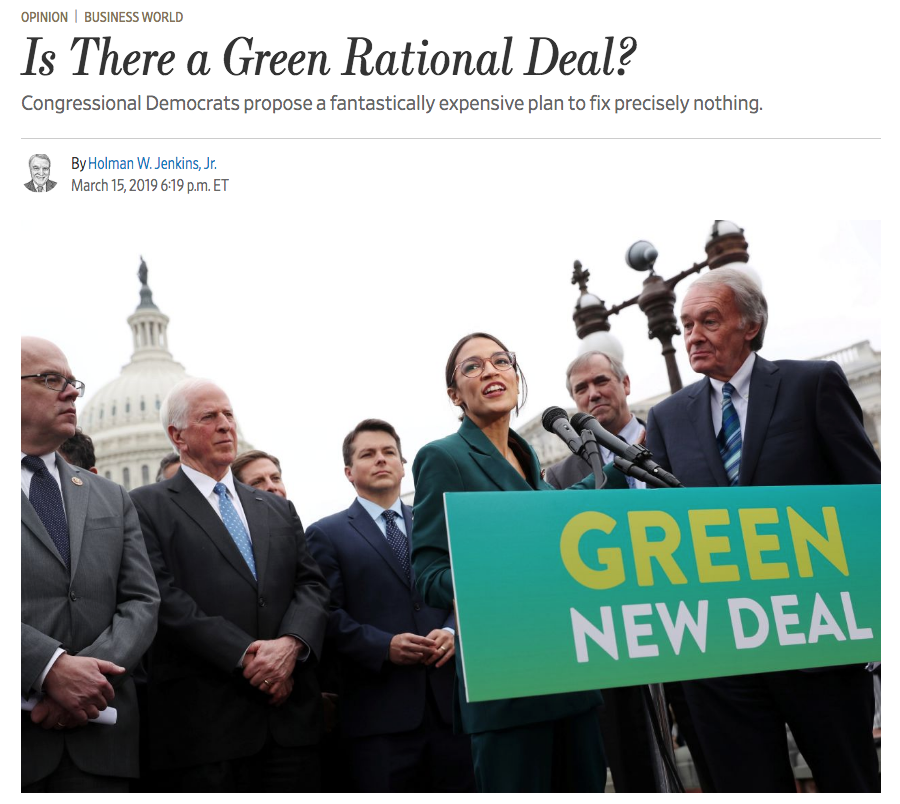There are few editorialists that many of us enjoy more than Holman W. Jenkins Jr. His twice-weekly “Business World” columns in the Wall Street Journal speak truth to power, including on the top-tier issue of energy and climate.
His March 16, 2019, piece, Is There a Green Rational Deal?, presents a government-activist alternative to the Green New Deal’s “fantastically expensive plan to fix precisely nothing.” But Jenkins errs in reaching for a silver bullet where, indeed, the fix is unnecessary, speculative, expensive, and not doable. And he defaults on the clear policy winner: free-market, wealth-is-health adaptation.

A New Proposal
Assuming model-driven, high-warming scenarios, Jenkins offers a multi-part government program to mitigate emissions and reverse manmade global warming.
Jenkins’s out-of-the-box proposal is a geoengineering fix whereby particles are injected in the air to reduce the sunlight reaching the earth, estimated to cost billions of dollars annually.
The second part of his “saner, no-regrets approach” to the Green New Deal (GND) starts with greater battery research (to help renewables overcome intermittency) and ending “irrational obstacles to nuclear power.” But the main intervention is a carbon tax. In Jenkins’s words:
Adopt a carbon tax as a pro-growth tax reform and hope the example catches on. Even if it doesn’t, any low-carbon energy technologies that emerge, if they are efficient and competitive, would be adopted by other countries.
Jenkins is proposing, in effect, GND-lite with a geoengineering twist. While arguably better than what is on the table from the Progressive Left, his alternative suffers from a raft of problems that make it a clear loser to the real alternative of less government and market adaptation.
Climate Science
The wide range of predicted anthropogenic warming is proof enough that the alleged problem is ill-defined and speculative. There are distinct positives from increasing atmospheric concentrations of greenhouse gases, and climate economists such as Robert Mendelsohn have calculated net benefits from the human influence at the lower end of the climate-model-driven IPCC range. The CO2 fertilization effect, and the benefits of moderate warming (natural or manmade), are behind this assessment.
Jenkins should not take high-range warming at face value given the out-the-window evidence of global lukewarming. He should also be aware of the logarithmic (not linear) forcing from greenhouse gas concentrations, meaning that the warming effect grows ever less with additions of CO2.
Jenkins should also examine the statistics of extreme weather events to see whether it indicates worsening climate change—or is just the bad luck of weather. A recent study of the peer-reviewed literature on hurricanes, for example, found little change in frequency and intensity, although warming can be expected to increase associated precipitation and storm surge. The data on droughts and floods are ambiguous too.
Public Policy
Each of Jenkins’s substitute policies for the GND are problematic in their own right.
First, geoengineering is untried and very controversial on both sides of the climate debate. “Playing God with climate” not only applies to anthropogenic warming but also anthropogenic cooling. Certain areas would be helped and others hurt within any aggregate temperature shift.
Second, making nuclear or batteries competitive has proven to be a mirage after much entrepreneurial (and governmental) effort. And presumably, a carbon tax is preferred to such micro-government policies aiming to reduce demand or lower the carbon intensity of supply.
Third, the carbon tax—along with its necessary equity adjustments and international trade barriers—is an intellectual loser and political unsalable.
Overall, Jenkins makes the common mistake of assuming market failure but neglecting analytic failure and government failure. Even assuming clear net societal costs from the anthropogenic warming, optimal public policy must avoid both over and under correction. Yet with uncertain science and debated economic impacts, perfect-knowledge solutions cannot come from even a well-intentioned intelligentsia.
Then comes politics. Can U.S. lawmakers do the “right” thing out of the gate, much less over time? And what about the other 190 political jurisdictions around the world? The failure of the Kyoto Protocol and the listing Paris climate accord makes any U.S.-side strategy ineffectual. (The U.S. accounts for only 15 percent of global emissions.)
Free Market, Anyone?
The Green New Deal and Green New Deal-lite are solutions looking for problems and certainly worse than the alleged disease. In place of a non-solution for an undefined problem, the best policy is reduced, not increased, government intervention in the U.S. economy.
The market alternative is a first-do-no-harm policy, what I have elsewhere described as a “no regrets” policy. And being a wealth creator, free markets are a self-help, adaptation creator.
Self-interested business practices will help determine whether the foe is weather or climate. Either way, there is clear evidence that adaptation is well underway given the extreme weather events to date. Seen another way, the costs of extreme weather are being internalized.
For example, the family-owned McIlhenny Company has built a $5 million, 20-foot levee around its Tabasco plant on Avery Island off the Louisiana coast to insure against flooding. The man-made barrier also helps preserve the island’s natural defense, the marsh. “For my family, it’s very important that Avery Island is here and we do a lot of work to protect it,” stated the great-great grandson of the company founder.
Conclusion
Climate change policy should not be a road to serfdom, with each government intervention leading to more intervention, reducing societal wealth and narrowing personal freedom. Intervention turns into central planning and authoritarianism where, as F. A. Hayek warned, the worst get on top.
The advantage of the free market is that analytic failure (central planning by an intellectual elite) and government failure (gaming by a political elite) are avoided. The incredible bread machine allows individuals and organizations to plan and protect against the vicissitudes of weather or climate.



